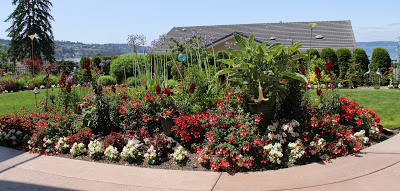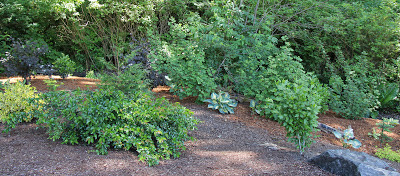The heavy rain we've been having was beating down some of my plants. In between rain showers, I've been staking them back up. I needed so many stakes I had to buy more.
The alstroemeria are blooming nicely, but they had quite a pounding from the rain.
June 26, 2013
I love my potting area / garden shed!
The thing I had that held tools was pretty wobbly, as evidenced by it falling on me and a tool cut my head. So this inspired John to make something to hang tools on the wall. Since the walls are solid cement, he had to drill into the cement to mount the tool rack. Then he helped sort through stuff and dispose of old chemicals and other stuff we don't use. After I did some additional tidying up, I took this photo.
You can see my worm bin on the right. My tool storage rack is along the back wall.
You can see my worm bin on the right. My tool storage rack is along the back wall.
Landscape Design Award
I was awarded the Landscape Design Award by the Washington State Federation of Garden Clubs for my "red, white, and blue" flower bed. This is the bed next to the spa.
The photos and description below are from my application:
The photos and description below are from my application:
The objectives of this garden bed were to have an attractive flower bed
to appeal to people sitting nearby on the patio (or in the spa) and to attract
hummingbirds and bees (to support pollinators). In addition, we didn’t want
plants too tall to block the view or create much shade.
The Choisya ternata ‘Aztec
Pearl’ and Heuchera ‘Crimson Curl’ provide evergreen year-round structure,
along with the garden art. The fuchsias and agapanthus are attractive well into
the fall.
While several of the plants were still small, I filled in with annuals,
as shown in the photos. In 2012, I planted white wax begonias along the eastern
edge of the bed, and I planted red snapdragons in empty spaces throughout the
bed. I also had a pot with a Brugmansia
(Angel’s Trumpet) sitting on one of the boulders. The plants have now grown
enough so I no longer need to fill in with annuals.
June 25, 2013
Award for "Gardening for Pollinators" Essay
I received a first place for horticulture essay from the Washington State Federation of Garden Clubs for my paper on "Gardening for Pollinators". See the December 6, 2012, blog entry for the content. I also received a 3rd place award for the plant list that goes with the essay.
I gave my Gardening for Pollinators presentation at the Neely Homestead Gardens on June 15, as part of their summer workshop programs.
I gave my Gardening for Pollinators presentation at the Neely Homestead Gardens on June 15, as part of their summer workshop programs.
June 10, 2013
Clematis Jackmani and Jackmanii Superba
These clematis thrive with this southern and western exposure. I usually place pots in front of them to provide a little shade to the lowest section. We've strung nylon rope (not smooth) from the upper deck to give them room to grow higher. Now we can enjoy from both levels!
The Jackmanii has a few open blooms, with many more coming. It blooms a little earlier than the Jackmanii Superba, so we enjoy the blooms for much of the summer.
Jackmanii Superba
Jackmanii
The Jackmanii has a few open blooms, with many more coming. It blooms a little earlier than the Jackmanii Superba, so we enjoy the blooms for much of the summer.
Jackmanii Superba
Jackmanii
Late Spring Garden
We returned from a trip to England in May 16 to find the garden looking lush and glorious! And it looks better every day. This is such a great time for the garden: It looks beautiful, there is promise of much more in coming months, and there is not much deadheading yet.
We've spent hours in the creek cleaning out weeds and watercress. The birds are so happy to have a nice place for drinks and baths! Can you see the bird in these pictures I took today?
The kalmia (mountain laurel) is covered in blooms, and the Cornus Kousa (dogwood) is in full bloom:
I'm happy with how the upper stream area is coming along. The doublefile viburnum finished blooming vacation, but the hillside is still looking good.
The big garden job now is pulling out crabgrass from the lawn. We've been hand-pulling out the individual weeds. I usually start with the flowering section, then rake through with my fingers to get where each plant is spreading. This leaves the "good grass" in the lawn. We work on it for 30 - 60 minutes at a time. It will be an ongoing process - probably never-ending, but hopefully much less as we go on. Next year, I'll look into an early application of a corn gluten based pre-emergent weed suppressant.
We've spent hours in the creek cleaning out weeds and watercress. The birds are so happy to have a nice place for drinks and baths! Can you see the bird in these pictures I took today?
The kalmia (mountain laurel) is covered in blooms, and the Cornus Kousa (dogwood) is in full bloom:
I'm happy with how the upper stream area is coming along. The doublefile viburnum finished blooming vacation, but the hillside is still looking good.
Rose garden:
Perennial bed on other side of rose garden. I planted the delphinium last year and am happy to see them return so nicely.The big garden job now is pulling out crabgrass from the lawn. We've been hand-pulling out the individual weeds. I usually start with the flowering section, then rake through with my fingers to get where each plant is spreading. This leaves the "good grass" in the lawn. We work on it for 30 - 60 minutes at a time. It will be an ongoing process - probably never-ending, but hopefully much less as we go on. Next year, I'll look into an early application of a corn gluten based pre-emergent weed suppressant.
Subscribe to:
Comments (Atom)

















